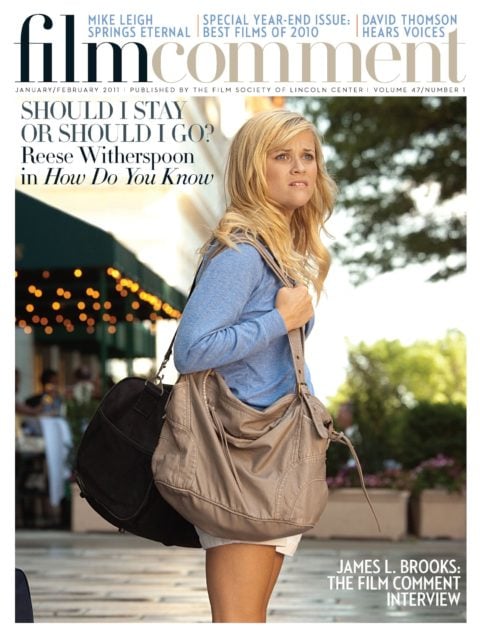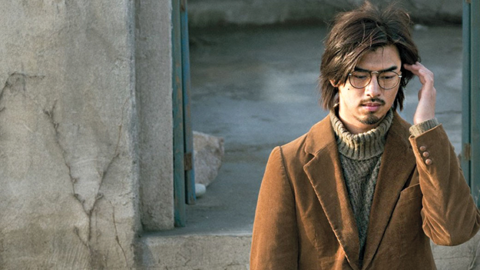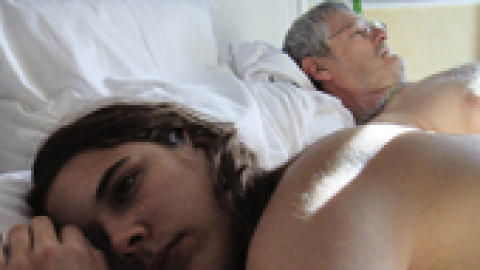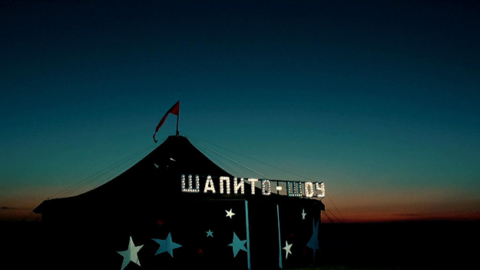
Chef-d’oeuvre
Chef-d’oeuvre?
(Luc Moullet, France)
Although ostensibly a short essay inquiring how masterpieces are identified and proclaimed in several art forms (with various apt comparisons and wry asides), this is ultimately a 13-minute defense of the short film itself—the form in which Moullet himself has created the greatest number of masterpieces (and about which he has written often as a critic, most recently in the French magazine Bref). The finale is a presentation of Méliès’ most famous short, Le Voyage dans la lune (1902), with Moullet’s own brilliant audio commentary.—Jonathan Rosenbaum
The Clock
(Christian Marclay, U.S.)
A tour de force of research, editing, and (needless to say) timing, this installation gathers film clips containing time references and splices them into a one-of-a-kind real-time experience. Utterly mesmerizing,The Clock works a paradoxical magic, causing you to lose all sense of time—while making you acutely aware of every passing minute. It’s also an out-and-out hoot, with a sublimely incongruous cast of unwitting thousands (Burt Reynolds, Romola Garai, Harold Lloyd, Julie Christie, etc.).—Jonathan Romney
Dancing Dreams
(Anne Linsel & Rainer Hoffmann, Germany)
This re-creation of Pina Bausch’s Kontakthof by a new generation is about transformation through art—and with its fluid pacing, lighting, and editing, it’s a work of art in its own right. The setting is industrial Wupperthal, the choreographer’s home base, and the kids who stumble and fall are traumatized refugees: a girl from Bosnia who witnessed her grandfather’s immolation, a Muslim boy from Romania, and gifted Joy, in mourning for her father. During the months of rehearsal, they come together in a magical performance, Bausch’s last choreographic triumph before her death in June 2009.—Joan Dupont
Dave Brubeck: In His Own Sweet Way
(Bruce Ricker, U.S.)
Ironically, the most popular American jazz musician is also one of the most undervalued among the cognoscenti. As the leading distributor of jazz documentaries (and Clint Eastwood’s jazz consultant), Bruce Ricker may be the ideal filmmaker to re-introduce Brubeck to a wider public. Although he regrettably doesn’t include a full performance of any song before the final credits, Ricker conveys what a wonderful person Brubeck is and gives a fine notion of some of the richness of his music.—Jonathan Rosenbaum

The Day of the Beast
The Day of the Beast
(Mikhail Konovalchuk, Russia)
Stranded behind enemy lines on the Russian front, a 16-year-old German sharpshooter holes up in a bombed-out building and watches through his rifle scope as civilization haltingly returns to life in a building across the courtyard. Slowly the story rekindles the momentary recognition of beauty and love in the flicker of a sniper’s eye. Konovalchuk excels at the feat of shooting a color film that’s virtually black and white, with barely a line of dialogue.—Harlan Jacobson
Disorder
(Huang Weikai, China)
Huang inaugurates a new genre: the City Cacophony Film. Taking Canton as his subject, he explodes the Romantic lyricism of Ruttmann and Cavalcanti into oblique shards as China’s third largest city, polarized by tradition and globalization, becomes a study in existential absurdity. A patchwork of amateur footage offers a berserk, scattershot glimpse into the public and private spheres of this modern metropolis. A distant cousin of Godard’s Weekend, shot through with Keystone Kops, discontented citizens, and a renegade pig, Disorder is an original, terrifying portrait of a society on the verge of a nervous breakdown.—Michael Chaiken
Double Tide
(Sharon Lockhart, U.S.)
Compared to the slow-motion procession of Lunch Break (08), Double Tide could be understood as a fast film: a 93-minute ode to real time focused on the ritual labors of a Maine clam-digger, in two fixed shots, one at dawn, the other at dusk. Fascinated with the rhythms of nature, Lockhart implements a strategy of repetition with variations that suggests a series of Monet studies. The film evokes the imagined clash of impressionist landscape painting and abstract expressionism, with the female worker’s footprints in the sand drawing like a final incarnation of Pollock’s drip paintings.—Manuel Yáñez-Murillo
Final Flesh
(Vernon Chatman, U.S.)
Chatman, the auteur behind such diamonds in the rough as Xavier: Renegade Angel, finally makes a feature—sort of. If we believe the backstory, he gave his screenplay to a production company that specializes in shooting custom-made porn from scenarios written by their customers. Chatman’s screenplay consisted mainly of surreal scenes full of absurd dialogue, like some apocalypse-themed cross between The Exterminating Angel and Dogtooth. Now imagine something along those lines, cut-rate and performed by rather less talented actors. Brain-frying.—Olaf Möller

Happy Few
Happy Few
(Antony Cordier, France)
Two couples swap partners, in what might be called a contractual arrangement. If it feels like a time capsule, it’s less due to setting (Paris in the first decade of the 21st century) or genre (not so far from vaudeville) than the horizon line of ’68-redolent Free Love. But this horizon is also Stendhalian: after all, the author dedicated The Charterhouse of Parma “to the happy few,” a group of dear friends and connoisseurs. Cordier’s audacity most certainly doesn’t reside in a desire to re-create a past utopia, but rather to remove the curse that continues to plague that ideal—a very bourgeois sense of contemporaneity.—Elisabeth Lequeret
The Karski Report
(Claude Lanzmann, France)
Lanzmann made this as an irrefutable-seeming argument in his dispute with fellow writer Yannick Haenel about the latter’s 2009 novel Jan Karski. By presenting previously unseen Shoah footage showing Karski’s account of the report he made to Roosevelt, Lanzmann tried to discredit Haenel’s—admittedly fictive—re-telling of that historical moment. But The Karski Report turned out to be much more: it’s a brief, brutally to-the-point essay on the boundaries of belief.—Olaf Möller
The Life Sublime
(Daniel V. Villamediana, Spain)
“Danger is the key to a sublime life,” affirms one of the characters in Villamediana’s second film, which sets out to reconstruct the mysterious trajectory that brought the director’s grandfather from Valladolid to Cádiz, but itself becomes a visionary journey. The film approximates an ethnographic approach to the topography and poetic aspects of southern Spain, while incorporating cinematic references to, among others, Victor Erice’s El sur. Filled with semi-improvised dialogue, like a work in progress, it ends by formulating a new hypothesis: what if danger were also the key to a sublime cinema?—Manuel Yáñez-Murillo
The Lips
(Iván Fund & Santiago Loza, Argentina)
Three women of different ages (played by Eva Bianco, Victoria Raposo, and Adela Sanchez) barely connect with one another as they travel to a rural hospital in ruins—their new home. Health workers on an impossible mission, they give care and listen to stories of stifled misery. One night, after a season of storms, they put on makeup for a festive outing with the locals—music, drink, attraction, and sensual community. So little happens during this journey, but lips tell stories, faces lighten, and there’s a touch of Cassavetes in the air.—Joan Dupont

Memory Lane
Memory Lane
(Mikhaël Hers, France)
Comment dit-on mumblecore en français? Having developed his distinctive undemonstrative style over several medium-length works, Hers delivers on his promise. Delicate, even borderline-precious, this is a minor film in the best sense, mapping the mundane flow of days over a summer in the Paris suburbs. Somehow the sense of present memory merging with recent experience makes for a dreamily elusive evocation of life lived between moments.—Jonathan Romney
O somma luce
(Jean-Marie Straub, France)
“O how all speech is feeble and falls short”—especially so when faced with Straub’s latest, derived from The Divine Comedy, specifically the epic poem’s concluding canto. The recipe: take Dante’s instinctive acceptance of God’s love. Stir in a few bars of Varese; slightly unreal sunlight-flooded landscapes (HD can do that); a chair sitting beside a plow; and a man (Giorgio Passerone) reciting Dante’s lines with curious fury. What do you get? A sense of grace, of paradise glimpsed.—Olaf Möller
Over Your Cities Grass Will Grow
(Sophie Fiennes, U.K.)
A mesmeric and utterly immersive work in which Fiennes’s ’scope camera prowls the grounds of artist Anselm Kiefer’s former Provençal residence-cum-what? Sculpture garden? Thirty-five-hectare organic installation? Gesamstkunstwerk? Kiefer is also observed in his studio: smashing glass and arranging the shards, manipulating hydraulic hoists like a paintbrush, chivvying assistants in the production of his expansive, enigmatic canvases. A fascinating, deeply engaging study of an artist at work (and the immense scale and scope of his ambition), and itself an example of film as art, it also features the best use of Ligeti since Kubrick.—Chris Darke
Potiche
(François Ozon, France)<br />The regal Deneuve plays a Seventies housewife gently resigned to the comfortable domesticity provided by her boorish husband (Fabrice Luchini), who suddenly finds herself in charge of the family’s umbrella factory. Based on a vaudeville play featuring one of those perfectly bourgeois yet entirely mad families so dear to Ozon, and painted in Jacques Demy pastels fortified by an undercurrent of camp, Potiche is like 8 Women but infinitely more sophisticated and subversive—a sweet candy with a sharp filling, a guilty pleasure without the guilt.—Joumane Chahine

The Roundup
The Roundup
(Roselyne Bosch, France/Germany/Hungary)
Just when you thought there couldn’t be another heartbreaking Holocaust story, Austrian director Roselyne Bosch recalls the 1942 roundup of Jews in Paris. Taken to the Winter Vélodrome stadium, people who thought they were Parisians become the stuff of backroom quota-bartering between the Nazi military and Vichy bureaucrats—with one notable addition to the canon: Bosch takes you into Marshal Pétain’s office and shows the bastard signing off on the liquidations.—Harlan Jacobson
Sodankylä Forever: The Century of Cinema
(Peter von Bagh, Finland)
Over the last quarter century, many of the best and the brightest have attended the Midnight Sun Film Festival in Sodankylä to talk about cinema. Out of literally hundreds of hours of taped public discussions, film historian Peter von Bagh carves a forceful, fast-moving, often melancholic but frequently funny essay about cinema as the essence of the 20th century. A smart work—half elegy, half rallying cry—by a master raconteur.—Olaf Möller
Studies for the Decay of the West
(Klaus Wyborny, Germany)
Wyborny’s latest flicker film concentrates on factories, industrial wastelands, waterways, cityscapes, and the bits in between, and has an uncanny emotional resonance. It is “serene, in the manner of ants”—to quote the title of the second section—but it is also elegiac and melancholy. Like two other old cranks (Godard and Straub), the director stays true to ideas about filmic composition gestated over many years and thereby provides a glimpse of a utopian cinema.—Thom Andersen
Winter Vacation
(Li Hongqi, China)
The funniest film since Goodbye, Dragon Inn, but actually it’s funnier—and a bit faster-paced. There is not a single superfluous action nor unnecessary cut. The sky is always empty over this dead-end town in Inner Mongolia, and not even an insulting tirade from a teacher “off his medicine” can break the lethargy of his students. He’s in the wrong classroom, as his substitute begins a lesson on “how to be a useful person.” Then there’s a cathartic eruption of punk rock from the Top Floor Circus on the soundtrack. If only the students could hear it.—Thom Andersen







